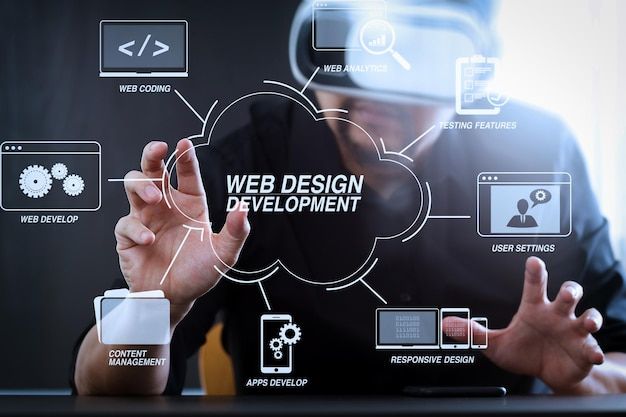Introduction to Web and E-Commerce Development
Welcome to the digital age—where your website is your storefront, and your e-commerce platform is your most powerful sales tool. Web and e-commerce development has evolved into a necessity for businesses of all sizes, helping them reach global markets, streamline operations, and increase sales.
The Rise of Modern Web Development
From Basic HTML to Interactive Websites
Web development has moved far beyond basic HTML pages. Now, it’s about creating responsive, dynamic, and highly interactive user experiences.
Mobile-First Design Is the New Norm
Since most users access the web from their phones, developers now prioritize mobile-friendly designs to ensure accessibility and performance on all devices.
What Is E-Commerce Development and Why It Matters
E-commerce development focuses on building, managing, and optimizing online stores. It covers everything from product listings and cart functionality to secure payment integration and post-sale support.
Popular Platforms in E-Commerce Development
Looking to launch your online store? Here are some top e-commerce platforms:
Shopify – Easy to use with lots of features.
Magento – Offers flexibility for large-scale businesses.
WooCommerce – Great for WordPress users.
BigCommerce – Scalable and rich in native features.
Choosing the Right E-Commerce Platform
Your platform should align with your business goals. Consider your product type, expected traffic, budget, and technical expertise before committing to a platform.
Technology Stack Behind a Successful Web and E-Commerce Site
Frontend Technologies
React.js – Popular for its speed and user experience.
Vue.js – Lightweight and easy to integrate.
Tailwind CSS – Fast styling with utility-first approach.
Backend Technologies
Node.js – Good for scalable applications.
Laravel – Powerful for secure and structured PHP projects.
Ruby on Rails – Quick development and clean code structure.
Databases and Hosting
Use MySQL, PostgreSQL, or MongoDB to store data.
Choose hosting platforms like AWS, Cloudways, or DigitalOcean for uptime and performance.
Why UX/UI Design Is a Game Changer
Mobile Responsiveness
A responsive website adapts to every device, keeping the user experience consistent and engaging.
Intuitive Navigation
Your site structure should feel natural. Users should be able to find what they need in a few clicks.
Speed Optimization
Slow-loading websites kill conversions. Minimize file sizes, use caching, and leverage CDNs to ensure fast load times.
Key Features Every E-Commerce Website Needs
Reliable Payment Gateways
Security builds trust. Use gateways like:
PayPal
Stripe
Razorpay
Google Pay
Always use SSL certificates and adhere to PCI standards.
User-Friendly Checkout
Simplify the checkout with:
Guest checkout options
Clear progress bars
Fewer form fields
Auto-complete address tools
Search Engine Optimization (SEO)
Optimize your site with:
Keyword-rich product titles and descriptions
Meta tags
Fast loading speed
Structured data markup
How to Scale Your Online Store
You need a system that can grow with you. Choose a flexible platform and infrastructure that can handle increased products, users, and data as your business expands.
Security Is Non-Negotiable
Protect your users with:
Two-factor authentication
Secure admin panels
Regular software updates
Firewall and malware detection
And make sure you’re GDPR-compliant if serving international markets.
Automation and AI in E-Commerce
Smarter Selling with AI
AI tools can:
Recommend products
Automate customer support (chatbots)
Analyze customer behavior
Send personalized emails
This saves time and improves customer satisfaction.
Future-Proof Trends in Web and E-Commerce Development
Voice-Activated Shopping
People are searching and shopping using voice commands. Optimize for conversational keywords.
Augmented Reality (AR)
AR lets users try before they buy—perfect for furniture, eyewear, and fashion.
Progressive Web Apps (PWAs)
PWAs combine the best of websites and mobile apps—fast, installable, and offline-capable.
Conclusion
In today’s digital economy, investing in quality web and e-commerce development isn’t optional—it’s essential. From choosing the right tech stack and designing an intuitive user experience to embracing AI and preparing for future trends, every decision plays a part in your brand’s success online. The key is to stay updated, scalable, and centered around the customer.
FAQs
1. What does web and e-commerce development involve?
It includes designing, developing, and maintaining websites and online stores for selling products or services.
2. Do I need to know how to code to build an e-commerce website?
Not necessarily. Platforms like Shopify and WooCommerce allow non-tech users to create full-featured stores.
3. How can I improve my site’s visibility online?
Invest in SEO strategies, create content, optimize speed, and ensure mobile responsiveness.
4. Is security important for e-commerce websites?
Absolutely. It’s essential for protecting customer data and building trust with your users.
5. What are the top tools for e-commerce development?
Popular tools include Shopify, Magento, Laravel, React.js, and payment gateways like Stripe and PayPal.
visit for more info : https://mindgigspk.com/
 :
https://www.pinterest.com/
:
https://www.pinterest.com/

